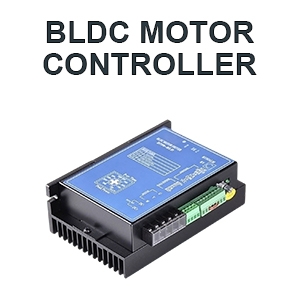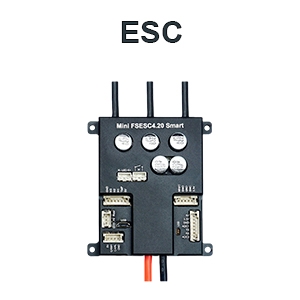Although BLDC Motor Controllers and ESCs (Electronic Speed Controllers) seem similar and, in some cases, may refer to the same thing, there are subtle differences between them. To better understand their relationship, let’s break down their definitions and key distinctions:
BLDC Motor Controller
A BLDC Motor Controller is an electronic device specifically designed to control Brushless DC (BLDC) motors. Its main role is to manage the motor's start, stop, speed, torque, and direction. The controller ensures the correct sequence of current flow through the motor's stator windings to drive the rotor’s rotation.

A typical BLDC motor controller performs several functions:
- Commutation Control: Ensures the correct sequence of energizing the stator windings based on the rotor's position to keep the motor running smoothly.
- Speed Control: Regulates the motor's speed by adjusting the amount of current or using Pulse Width Modulation (PWM).
- Torque Control: Manages the current to control the motor's torque output.
- Feedback Mechanism: May use Hall-effect sensors, encoders, or Back EMF (electromotive force) to detect the rotor's position and speed.
In summary, a BLDC Motor Controller is a broader term used to describe an electronic device that controls all aspects of a BLDC motor, including speed, torque, and commutation.
ESC (Electronic Speed Controller)
An ESC is a specialized controller primarily used to regulate the speed of electric motors, particularly in electric models or drone applications. It can also control the motor's direction (for forward or reverse rotation), but ESCs are often designed for electric models such as remote-controlled cars, aircraft, and drones.

An ESC typically performs the following functions:
- Speed Control: Adjusts the motor speed by controlling the PWM signal applied to the motor.
- Direction Control: Switches current polarity to control motor rotation (forward or reverse).
- Overload Protection: Includes features like overcurrent protection and thermal protection.
- Interface with Remote Systems: ESCs often work with flight controllers, remote controls, or other input signal sources.
ESCs are most commonly found in drones, RC cars, RC aircraft, and other consumer-grade products, and they are mainly focused on precise speed control. They may not provide the same level of torque regulation or commutation features as a full BLDC Motor Controller.
Differences and Relationship
| Feature | BLDC Motor Controller | ESC (Electronic Speed Controller) |
| Functionality Scope | a more general-purpose controller designed to control all aspects of a BLDC motor, including commutation, speed, and torque. | usually focused on speed control and is designed for electric models, such as RC vehicles, drones, and other consumer applications. |
| Application Range | can be used in a wide range of industries, robotics, and automation systems. | more commonly used in electric models, drones, or other specific consumer applications. |
| Control Precision | provides more precise control, including torque and position control, which is crucial for industrial or high-performance applications. | mainly focuses on speed control and usually doesn’t have the high-precision position and torque control features that a BLDC Motor Controller would provide. |
Conclusion
Although BLDC Motor Controllers and ESCs overlap in some areas, they are not the same thing. A BLDC Motor Controller is a more general term that encompasses all aspects of controlling a BLDC motor, suitable for industrial and high-performance applications. An ESC, on the other hand, is more specialized in speed control and is typically used in electric models like remote-controlled cars, drones, and other consumer products.
Therefore, an ESC can be considered a type of BLDC Motor Controller, but the two differ in their applications and features.
